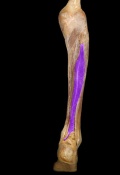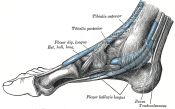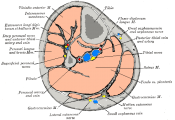Flexor hallucis longus
Original Editor - George Prudden
Top Contributors - George Prudden, Kim Jackson, Patti Cavaleri, 127.0.0.1, Evan Thomas and WikiSysop;
Description[edit | edit source]
Flexor hallucis longus (FHL) is a powerful muscle located on the posterior aspect of the fibula below the deep fascia of the calf. In its own synovial sheath, the tendon passes downwards, deep to the flexor retinaculum, crossing the posterior ankle joint, lateral to flexor digitorum longus. The tendon wraps around the lower end of the of the tibia, the back of the talus, and the inferior surface of the sustentaculum tali on the calcaneus, where its passes through a fibrous, synovial-lined tunnel.[1]
As the tendon enters into the sole of the foot it lies superficial to the spring ligament passing forward deep to the tendon of flexor digitorum longus. It then enters the fibrous sheath of the great toe passing between the two sesamoid bones to insert at the base of the distal phalanx of the great toe.[1]
Origin[edit | edit source]
Lower two-thirds of posterior fibula.
Insertion[edit | edit source]
Plantar surface at the base of the first distal phalanx.
Nerve[edit | edit source]
Branch of the tibial nerve (root S1 and S2).
Cutaneous supply from root S2.
Artery[edit | edit source]
Peroneal artery[2]
Function[edit | edit source]
Flexes all the joints of the great toe as the foot is raised from the ground. Additionally stabilizes the first metatarsal head and keeps distal pad of the great toe in contact with ground in toe-off and when on tip-toe.
Aids in plantarflexion at the ankle joint.[2]
Clinical relevance[edit | edit source]
Flexor hallucis longus produces the final thrush from the foot in the toe-off phase of the gait cycle. At this point in the cycle, triceps surae have already maximally contracted and flexor digitorum longus is completing its contraction. Therefore great toe flexion is the final act before the foot is lifted from the floor before swing phase.
The muscle contributes to maintaining the medial longitudinal arch.
Fractures of the sustentaculum tali can cause entrapment of the flexor hallucis longus or flexor digitorum longus tendons amongst other abnormalities that may indicate reconstructive surgery. Post-operative management includes the use of a lower leg splint for 5-7 days, partial weight-bearing with 20 kg for 6-8 weeks in the patient's own footwear, early range of motion exercises of the ankle, subtalar and mid-tarsal joints. Outcomes are generally good with those sustaining isolated fractures performing better.[3]
Tendinopathy and other dysfunctions of the FHL in dancers due to the repetitive forceful plantarflexion and stabilization required of the FHL. FHL tendinopathy can be an isolated injury or part of posterior ankle impingement[4].
Assessment[edit | edit source]
Palpation[edit | edit source]
Palpation is impossible due to the muscles depth and the structures obstruct surface palpation.
Power[edit | edit source]
Resisted flexion of great toe with the foot in neutral or dorsiflexion.
Length[edit | edit source]
In supine or seated, with ankle in dorsiflexed position. Stabilise proximal bone of joint to be measured. Extend the joint to be measured through available ROM.[5]
Treatment[edit | edit source]
Strengthening[edit | edit source]
A common exercise for foot strength is performed using a towel. Ask the patient to sit and place a towel under their foot, then ask the patient to grip the towel with their great toe thereby moving the towel along the floor. This can also be done through a larger range using a theraband around the great toe.
The muscle can be strengthened by utilizing its role in balance. Providing a patient with a suitably challenging balance exercise such as using wobble board makes exercise more functional.
Further in rehabilitation, walking or running on different surfaces such as grass or sand will further challenge the function of flexor hallucis longus.
Stretching[edit | edit source]
A stretch can be performed by pulling the great toe into a extended position and the ankle into a dorsiflexed position. Similar to strengthening, a towel may be useful if the patient is struggling to reach forward. It can be wrapped around the toes and ball of the foot.
Surgical Intervention[edit | edit source]
Tendonitis of the FHL can occur due to friction of the tendon or elongated muscle belly in the fibro-osseus tunnel during repetitive sporting or physical activities, such as dancing en pointe. If patient's fail to have significant improvement in symptoms and functional limitations with conservative management, they may be referred to an orthopedic surgeon for arthroscopic surgery.
One study followed 34 patients who underwent FHL muscle belly partial resection to decrease impingement of the muscle belly in the tendon sheath[6]. All patients reported full resolution of pain and normal motion for the ankle and first hallux by the final follow up (12-36 months, mean follow up 25.4 +/- 8.5 months)[6].
Extensive tenosynovectomy through arthroscopic surgery has also demonstrated significant improvements in pain, clinical examination measurements, and standardized scales in a study of 14 patients[7].
Resources[edit | edit source]

|

|

|

|
See also[edit | edit source]
- Flexor digitorum longus
- The Os Trigonum Syndrome
- Tarsal Tunnel syndrome
- Posterior Tibial Tendon Dysfunction
- Ankle & Foot
- Compartment Syndrome of the Foot
- Ankle Impingement
- Hallux Valgus
- Ankle Joint
- Congenital talipes equinovarus (CTEV)
References[edit | edit source]
- ↑ 1.0 1.1 Palastanga N, Soames R. Anatomy and Human Movement: Structure and Function. 6th ed. London, United Kingdom: Churchill Livingstone; 2012.
- ↑ 2.0 2.1 Saladin K. Anatomy & physiology: The Unity of Form and Function. 5th ed. New York: McGraw-Hill; 2010.
- ↑ Dürr C, Zwipp H, Rammelt S. Fractures of the sustentaculum tali. Operative Orthopädie und Traumatologie. 2013 Dec;25(6):569–78.
- ↑ Sharpe BD, Steginsky BD, Suhling M, Vora A. Posterior Ankle Impingement and Flexor Hallucis Longus Pathology. Clin Sports Med. 2020 Oct;39(4):911-930.
- ↑ Reese NB, Bandy WD, B WD, Y MM. Joint range of motion and muscle length testing. Philadelphia: Saunders (W.B.) Co; 2002 Jan 15. ISBN: 9780721689425.
- ↑ 6.0 6.1 Feng SM, Sun QQ, Wang AG, Fan JQ. Flexor Hallucis Longus Tendon Impingement Syndrome: All-inside Arthroscopic Treatment and Long-term Follow-up. J Foot Ankle Surg. 2020 Nov-Dec;59(6):1197-1200.
- ↑ Qu, W. et al. (2019) ‘Effect of extensive tenosynovectomy on diffuse flexor hallucis longus tenosynovitis combined with effusion’, Journal of Orthopaedic Surgery. doi: 10.1177/2309499019863355.







